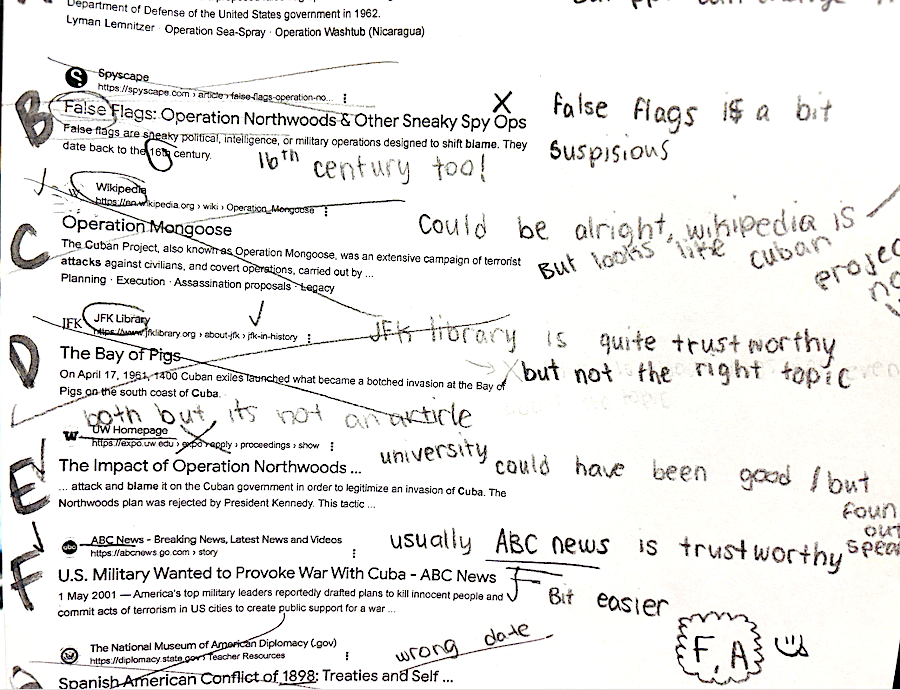Media Literacy Moments Throughout Your Day
A MiddleWeb Blog
 The title of this post is a misnomer, as media literacy is a lifelong process, but teachers often only have moments to dedicate to helping students learn about it.
The title of this post is a misnomer, as media literacy is a lifelong process, but teachers often only have moments to dedicate to helping students learn about it.
After reading the News Literacy Project’s 2024 survey on teen literacy habits and attitudes, I knew that I needed to prioritize finding as many minutes as I could to devote to this important skill.
Inspired, I took a free online course with Digital Inquiry Group this fall and discovered so much excellent information to adapt for my social studies classes that I highly recommend it.
One of the first things we practiced in class this year was looking at how headlines differ, based on the perspective of the news source. We learned what it means for a source to lean right or left, and then used headlines from Allsides.com to make comparisons.
This was a valuable practice during election season, when the same event was spun in different ways. By practicing this skill, I hope that students will consider the bias of headlines when they come across them in their daily lives.
Looking deeper into the influence of AI
In my classroom, we always start with a Question of the Day, which is a way to get students talking with each other. Usually they are fun questions that are meant to cause excitement. I’ve started to sprinkle in a slide with two photos, and students have to decide which one is the AI. This activity has trained them to look for inconsistencies, to try to read any text in photos, and to check the lighting.
This quiz isn’t just about distinguishing between pictures; it delves into the fascinating world where AI, having learned from countless authentic images, creates deceptively realistic visuals. Here, your mission is to separate these images from reality.” – Instructions from Britannica’s quiz.
Before including this as a routine practice, we took a few minutes in separate classes to take the Britannica Education Real or AI Quiz and the New York Times quiz on which faces were made by AI. The Britannica Education page has excellent questions for students to consider, as well as common AI trademarks. The New York Times quiz is extremely challenging, and a good lesson for students about how realistic a fake image can look.

Testing the credibility of conspiracy theories
According to the News Literacy Project’s report, 80% of teens have seen conspiracy theories on social media, and more than half believe them. Students need frequent practice vetting social media posts for credibility. The Digital Inquiry Group’s course had many practice sources to use, as well as video explanations on how they would search for reliability.
I’ve taken the template that DIG created, and used social media posts I’ve collected to create practice slides for my students. They share a laptop for their research so that they can discuss their thinking, which also helps me understand their reasoning, as I circulate.
One way to make this activity more engaging is to have students make a prediction about if the source is reliable or not, before they do any research. This small investment is enough to spur some enthusiastic lateral reading.
Does much of your students’ independent research come from the first two results on Google? The Digital Inquiry Group has an excellent video on click restraint and how to navigate a page of search results that all look trustworthy. We talk about the deceptive techniques behind Search Engine Optimization and how we can outsmart this process to find the information we need.
Here’s a prompt that sets up students for analyzing Google search results:
We have done practice rounds with paper printouts of a Google search on a few conspiracy theories. The best way to practice click restraint is to not be able to click! Students take notes next to each source and think about why it would or would not be the best place to start their research.
Their notes on paper offer so much insight into how they process information and allow me to clarify misconceptions, like the belief that the suffix .org makes a site credible. Their favorite part of the process is when we discover if a conspiracy theory is true or not. It always leads to lots of curious questions.
Media literacy skills deserve classroom time
Media literacy and critical thinking are skills that our students must practice frequently and in a way that energizes them to do it on their own time. By intentionally including it across subject areas, students will build the muscles they need to be responsible consumers and creators of media. This work is only just beginning and deserves the serious attention of educators everywhere.







































